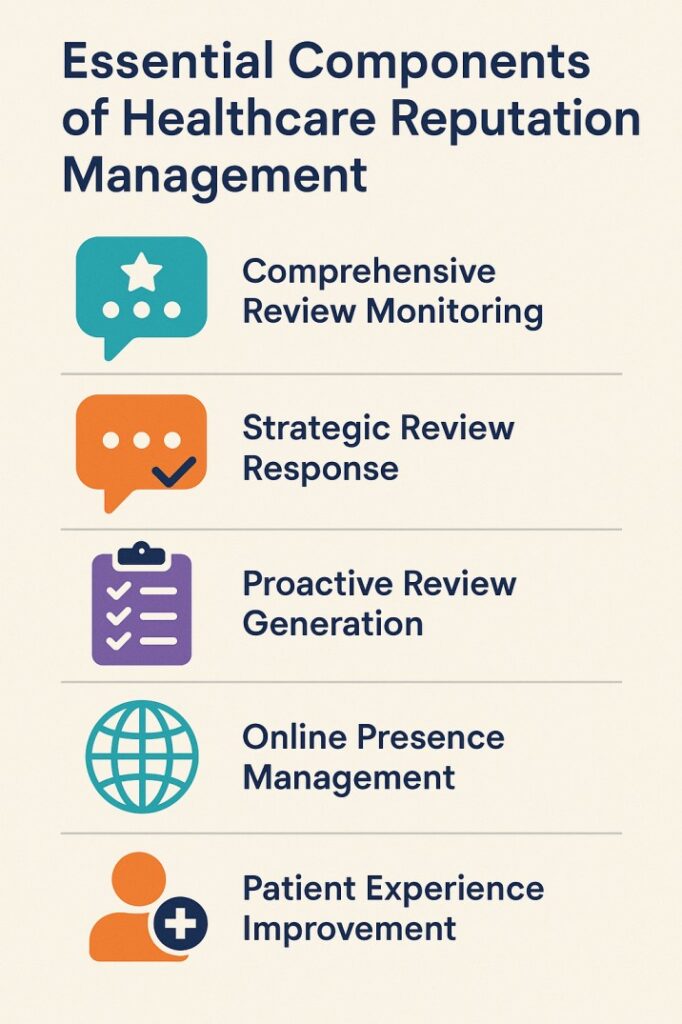Healthcare Industry Needs Better Mobile Solutions
The digital transformation of healthcare has fundamentally changed how patients select their medical providers. With smartphones in hand, patients now research doctors, hospitals, and clinics before scheduling appointments—reading reviews, checking ratings, and forming impressions long before any in-person interaction occurs. For healthcare providers across India and globally, this shift represents both a challenge and an opportunity.
Recent studies reveal that 94% of healthcare patients use online reviews as part of their provider selection process, while 84% trust these reviews as much as personal recommendations. These statistics highlight an undeniable truth: your online reputation directly influences patient acquisition, retention, and ultimately, your practice’s success.
Healthcare online reputation management goes beyond simply monitoring reviews—it encompasses a comprehensive approach to building trust, showcasing clinical excellence, and fostering meaningful connections with patients in digital spaces. In an increasingly competitive healthcare landscape, providers who take control of their online presence gain a significant advantage.
This guide explores practical strategies that healthcare organizations—from small private practices to large hospital systems—can implement to build, protect, and improve their online reputation. Whether you’re serving patients in Mumbai or Manhattan, these approaches will help you create a digital presence that accurately reflects your commitment to quality care.
Understanding the Healthcare Online Reputation Management
Today’s healthcare consumer journey typically begins online, well before any clinical interaction:
- Search phase: Patients use search engines to find providers for specific symptoms, conditions, or treatments
- Research phase: They read reviews, browse provider websites, and check social media profiles
- Selection phase: Based on this information, they choose providers they believe will deliver quality care
- Experience phase: The actual clinical encounter occurs
- Sharing phase: Patients share their experiences through reviews, social media, and word of mouth
At each stage, your online reputation influences patient decisions and perceptions. Understanding this journey allows you to strategically manage your digital presence at critical touchpoints.
The Business Impact of Your Online Reputation
The connection between reputation management and business outcomes is direct and measurable:
- Patient acquisition: 75% of patients select healthcare providers based on positive reviews
- Revenue growth: Practices with 4+ star ratings typically see 30% higher revenue growth than lower-rated competitors
- Staff recruitment: Top medical talent increasingly considers an organization’s online reputation when making employment decisions
- Insurance negotiations: Some payers now factor patient satisfaction and online ratings into reimbursement decisions
For healthcare providers in India specifically, where the private healthcare sector is growing at 15% annually, standing out in an increasingly crowded marketplace requires attentive reputation management.
Essential Components of Healthcare Reputation Management

1. Comprehensive Review Monitoring
Effective monitoring requires attention to multiple platforms where patients discuss their healthcare experiences:
- Medical-specific platforms: Practo, Healthgrades, Zocdoc, RateMDs
- General review sites: Google Business Profile, Yelp
- Social media: Facebook, Twitter, Instagram
- Healthcare directories: Local medical associations, insurance provider directories
- Forums and discussion boards: Condition-specific patient communities
Tools that aggregate reviews across platforms can simplify monitoring, but the human element remains crucial for understanding context and sentiment.
2. Strategic Review Response
How you respond to patient feedback significantly impacts your reputation:
- Positive reviews: Acknowledge and thank patients while maintaining HIPAA/privacy compliance
- Negative reviews: Address concerns professionally, avoid defensive language, and offer to take discussions offline when appropriate
- Neutral reviews: Engage thoughtfully to turn neutral experiences into positive ones
Response timing matters—aim to address negative feedback within 24-48 hours to demonstrate responsiveness and concern for patient satisfaction.
Sample response template for negative feedback:
“Thank you for sharing your experience. We’re sorry to hear your visit didn’t meet expectations. We take all feedback seriously and would appreciate the opportunity to address your concerns. Please contact our patient experience coordinator at [private number/email] so we can learn more and work toward a resolution.”
3. Proactive Review Generation
Many satisfied patients don’t naturally think to leave reviews. Implementing systematic approaches to gathering feedback helps create a more representative picture of your practice:
- Post-visit email or SMS prompts sent 1-3 days after appointments
- Tablet-based feedback stations in waiting or check-out areas
- QR codes on appointment cards linking directly to review platforms
- Trained staff who verbally request reviews from satisfied patients
- Follow-up calls that include review requests when appropriate
The key is making the process convenient while timing requests when patient satisfaction is highest.
4. Online Presence Management
Your digital footprint extends beyond review sites to include:
- Website optimization: Clear service descriptions, provider credentials, and patient resources
- Google Business Profile: Complete, accurate information with regular updates and posts
- Social media presence: Regular, engaging content that highlights expertise and patient success stories
- Directory listings: Consistent name, address, phone number (NAP) information across all platforms
- Search engine optimization: Strategic use of healthcare terms patients actually search for
For multi-location practices or hospital systems, location-specific strategies ensure patients find the most relevant information for their needs.
5. Patient Experience Improvement
Online reputation management ultimately connects to real-world patient experiences:
- Wait time reduction initiatives
- Communication skills training for clinical and front office staff
- Simplified billing processes
- Clear appointment scheduling systems
- Comfortable physical environments
- Follow-up protocols for patient concerns
The most successful reputation management strategies tie online feedback to operational improvements, creating a continuous cycle of enhancement.
Special Considerations for Indian Healthcare Providers
The healthcare landscape in India presents unique opportunities and challenges for reputation management:
- Mobile-first access: With over 700 million smartphone users, ensure your digital presence is optimized for mobile devices
- Language considerations: Consider multilingual review response capabilities for regional languages
- Trust building: In a market with varying standards of care, transparency about credentials and outcomes is especially important
- Regional platforms: While global platforms matter, India-specific sites like Practo and Lybrate deserve special attention
- Family decision-making: Content that addresses family members involved in healthcare decisions can be particularly effective
Creating a Reputation Management Action Plan Immediate Actions (First 30 Days)
1. Conduct a comprehensive audit
- Document current ratings across all platforms
- Identify patterns in negative feedback
- Assess competitor ratings and responses
- Evaluate website patient experience
2. Claim and optimize all online listings
- Verify ownership of all profiles
- Update contact information, hours, and services
- Add professional photos of facilities and providers
- Complete all available fields with relevant information
3. Develop response protocols
- Create templates for different types of feedback
- Establish an escalation process for serious complaints
- Designate responsibility for monitoring and responding
- Set response time standards
Medium-Term Strategy (2-6 Months)
1. Implement systematic review generation
- Choose appropriate technology solutions
- Train staff on requesting reviews
- Create patient-friendly instructions for leaving feedback
2. Content development
- Publish educational articles addressing common patient questions
- Create short videos introducing providers and explaining procedures
- Share patient testimonials (with proper consent)
- Develop informative social media content calendar
3. Patient experience improvements
- Address top issues mentioned in negative reviews
- Create feedback loops between online reviews and staff training
- Implement service recovery protocols for dissatisfied patients
Long-Term Approach (6+ Months)
1. Reputation analytics
- Track changes in ratings over time
- Measure impact of improvement initiatives
- Compare performance across locations or departments
- Calculate ROI of reputation management efforts
2. Advanced content strategy
- Develop condition-specific educational resources
- Create thought leadership content highlighting expertise
- Participate in online health communities
- Showcase community involvement and outreach
3. Integration with overall marketing strategy
- Use positive reviews in advertising materials
- Highlight patient satisfaction metrics in communications
- Incorporate reputation goals into broader marketing objectives
Handling Reputation Challenges
Even the best healthcare providers occasionally face reputation challenges. When difficult situations arise:
1. Assess the situation objectively
- Determine if criticism reflects an isolated incident or systematic issue
- Gather facts from all involved parties
- Review relevant medical records with privacy considerations in mind
2. Respond appropriately
- Address legitimate concerns with transparency
- Correct factual inaccuracies without being defensive
- Focus on resolution rather than blame
- Document all communication
3. Implement preventative measures
- Use negative feedback to identify process improvements
- Strengthen staff training in problem areas
- Create early warning systems for potentially dissatisfied patients
- Develop service recovery protocols
4. Monitor for impact
- Track subsequent reviews for similar issues
- Follow up with concerned patients when appropriate
- Assess whether changes are improving patient feedback
Building Long-Term Patient Loyalty
Reputation management ultimately serves a greater purpose: creating lasting relationships with patients. Beyond managing reviews, consider:
- Patient appreciation programs that recognize loyal patients
- Personalized communication based on patient history and preferences
- Community involvement that demonstrates commitment beyond clinical care
- Health education initiatives that provide value beyond appointments
Transparent quality metrics that showcase commitment to excellence
Measuring Success
Quantitative measures:
- Average star ratings across platforms
- Review volume and frequency
- Response rates and times
- Appointment conversion rates from online sources
Qualitative indicators:
- Sentiment analysis of review content
- Quality of patient comments
- Staff feedback on patient interactions
- Depth of patient engagement with content
Conclusion
In healthcare, your reputation has always mattered—but the digital age has amplified its importance and changed how it develops. Online reputation management isn’t about creating a false image; it’s about accurately representing the quality care you provide and addressing shortcomings when they occur.
For healthcare providers in India and globally, taking a strategic approach to online reputation management allows you to shape the narrative around your practice, build patient trust, and ultimately deliver better care experiences. As patients increasingly begin their healthcare journeys online, the providers who thoughtfully manage their digital presence will be the ones patients choose to entrust with their care.
By implementing the strategies outlined in this guide—monitoring reviews, responding thoughtfully, generating feedback, managing your online presence, and improving patient experiences—you create a virtuous cycle that benefits your practice and patients alike. In today’s connected world, your online reputation isn’t just about what people find when they search for you—it’s about creating relationships that begin before patients enter your facility and continue long after they leave.






